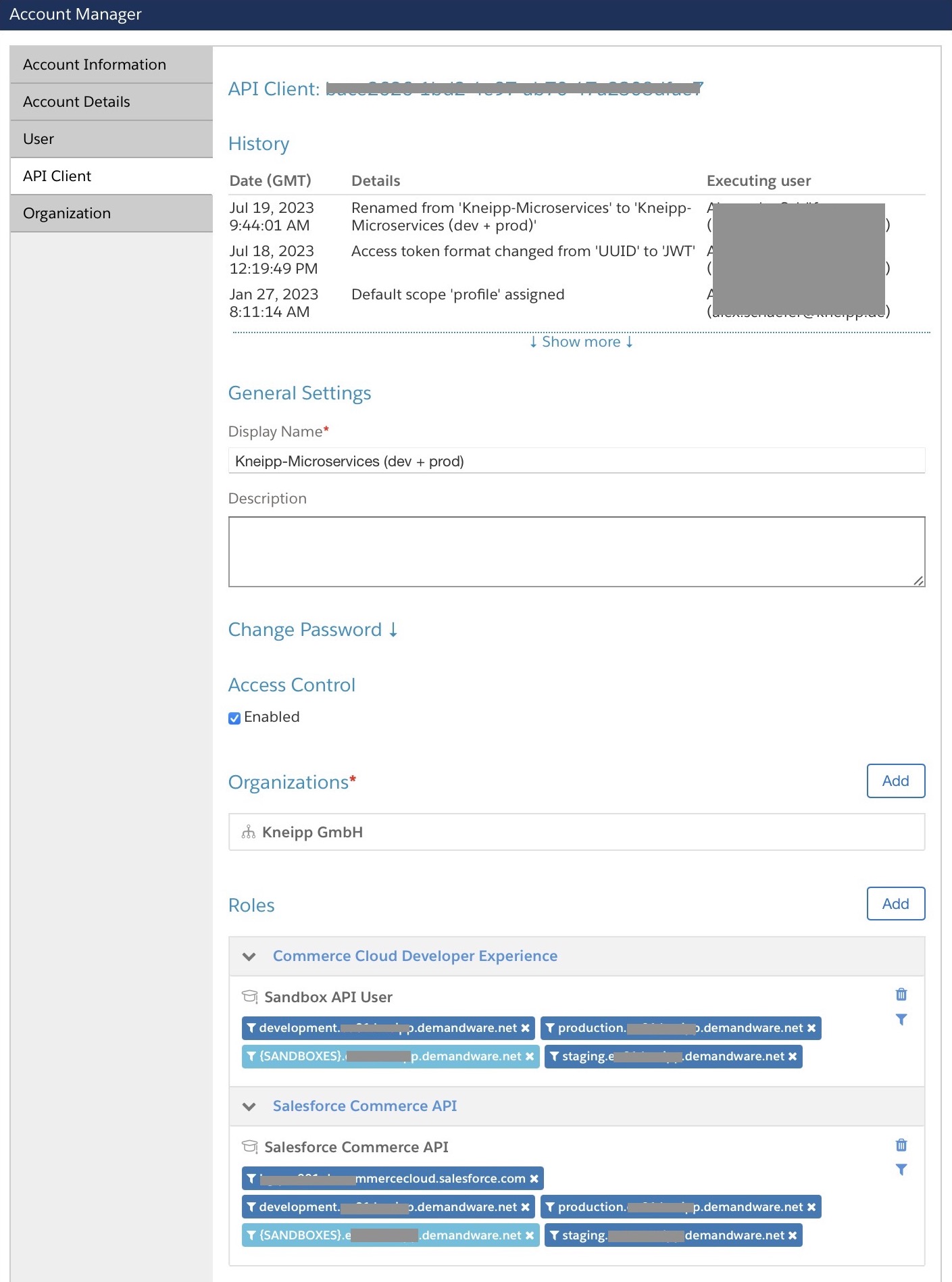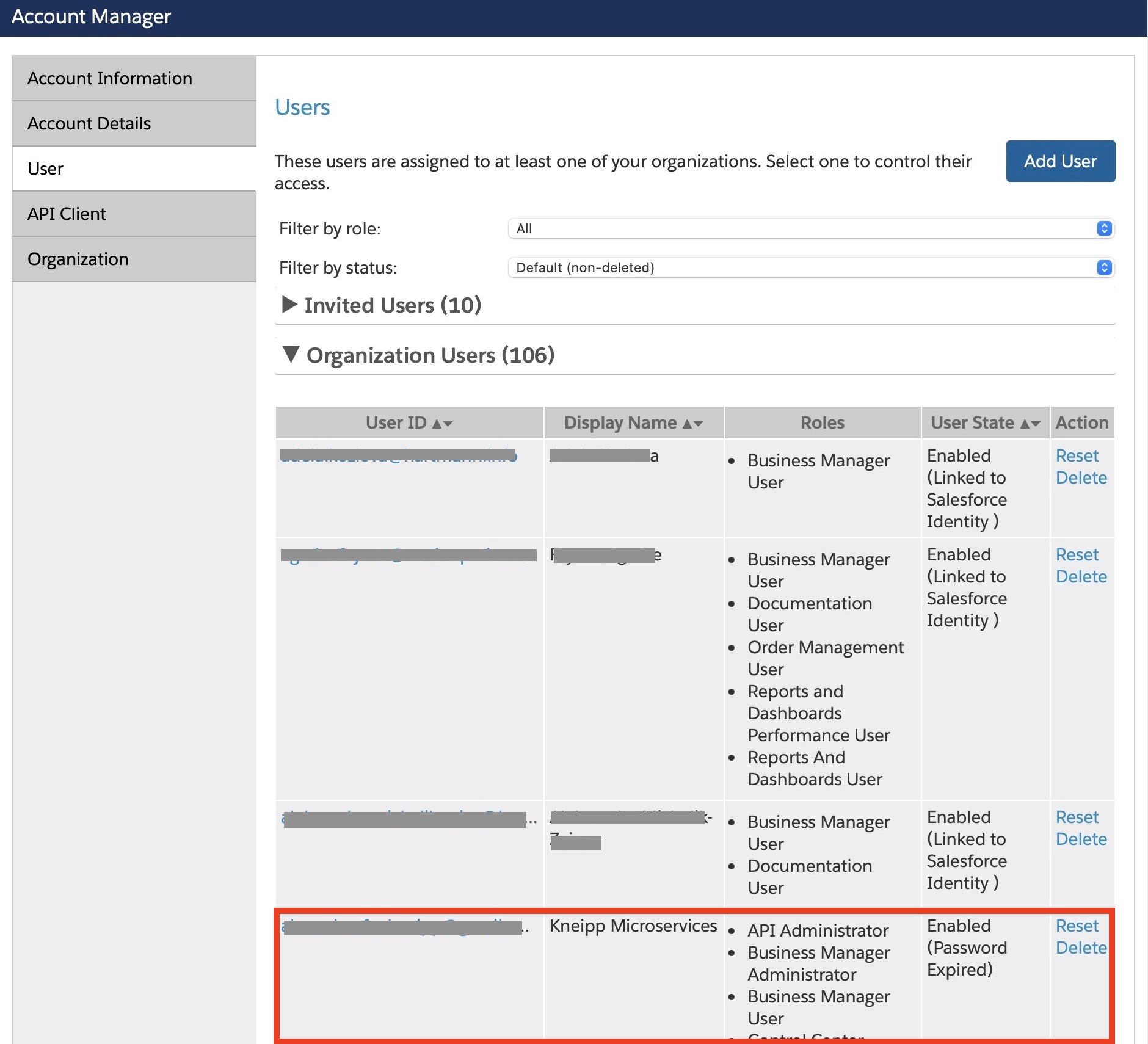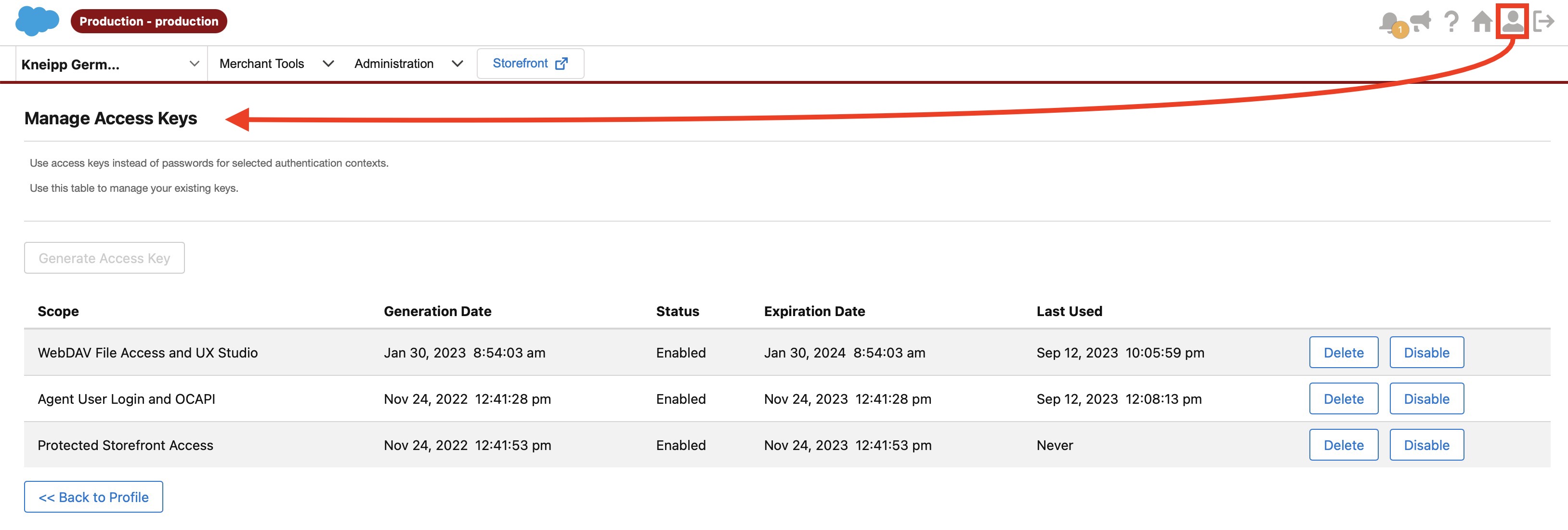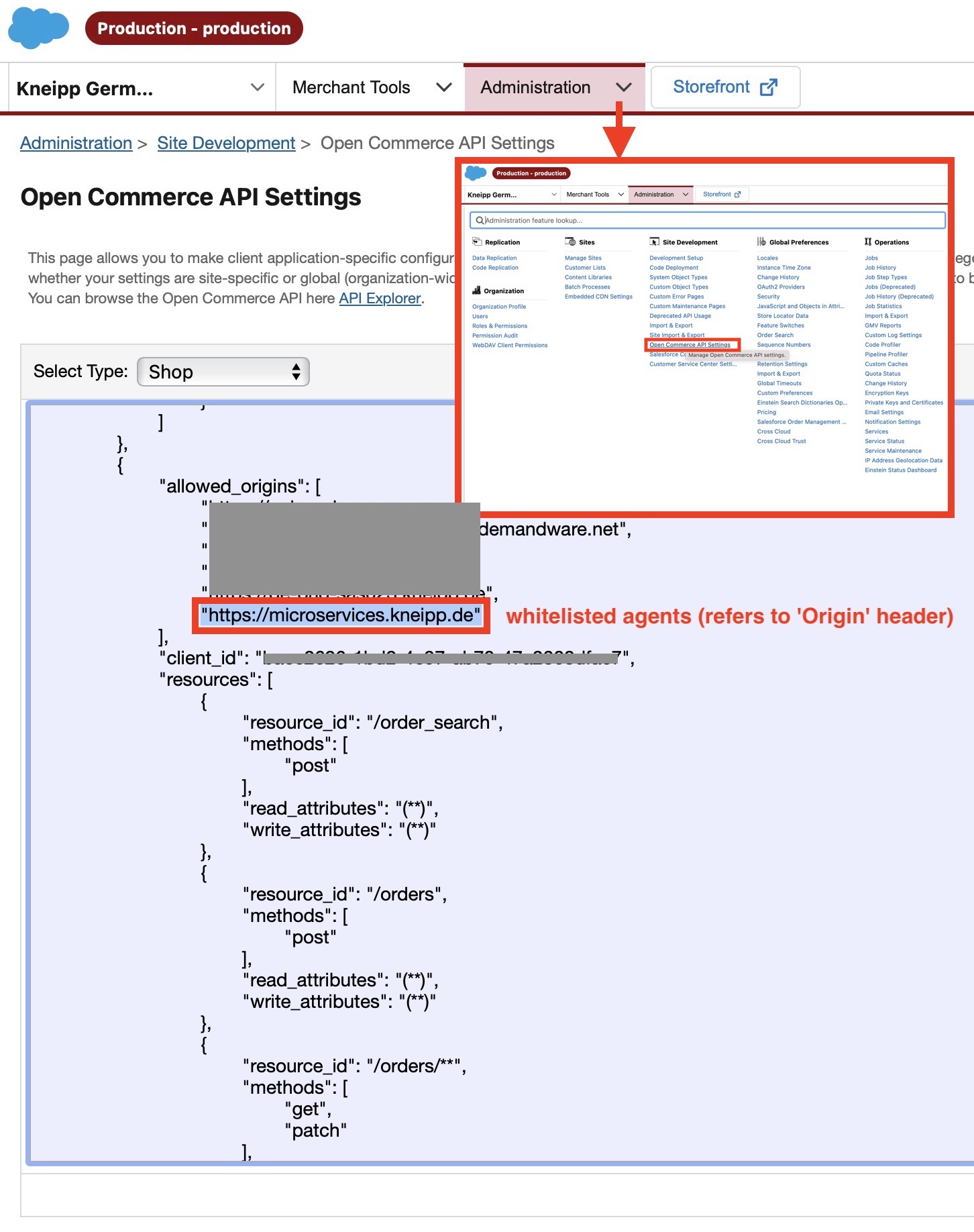Salesforce OCAPI Request Client
Want to use Salesforce Open Commerce API but don't know where to start, how to configure or how to use it? Well, I (soon) have an entire online course about OCAPI!
For deeper understanding inspect the source code and look through the examples. Visit 'GitHub Issues' if you want to send a bug report.
Installation
Run npm i sfcc-ocapi-request to install this NPM package.
Imports
const {request, pageloop, credentials} = require("sfcc-ocapi-request")
const {fetch} = request
const {
ACCESS_KEYS,
addAccessKey,
SUPPORTED_ENVIRONTMENTS,
isSupportedEnvironment,
getSupportedEnvironment,
addSupportedEnvironment,
removeSupportedEnvironment,
ENVIRONMENT_DOMAINS,
addEnvironmentDomain
} = credentialsThe request object contains functions to make HTTP and SFCC OCAPI calls. - For example, request.fetch() is basically just a wrapper around needle and can be used for generic REST requests. On the other hand, you can use request[ENVIRONMENT].data() and request[ENVIRONMENT].shop() to call DATA or SHOP Commerce APIs. - (You need to replace the ENVIRONMENT placeholder by a string like "staging".) - For example: request.development.data() or request.production.shop().
The pageloop() utility returns a generator function which can be used with for-loops, for example:
const query = request.staging.shop("GET", "/customer_lists/CustomerListName/customers/0123456789", "-") // 3rd argument is Business Manager Site ID or Organization scope, denoted by '-'
for await(const response of pageloop(query)) { // note, how `query` is a Promise but `pageloop()` will resolve it automatically
console.log(response)
}The credentials object contains some helpers for managing the Salesfoce Commerce environments with their appropriate access keys. - Typically, you will have multiple SFCC environments and a couple different access keys based on those available environments.
Access Keys
This package supports the simple and the advanced authentication methods. - The simple one uses API client credentials only (like its ID and password) to authorize your request to Salesforce Commerce. The downside of this authorization method is that it is only permitted to make requests to the shop OCAPIs. - The advanced authentication method on the other hand, uses a combination of Business Manager credentials, plus the API client. The advanced authorization can access both API realms (data and shop) at the same time but you will need to have both, a BM User + an API Client.
credentials.ACCESS_KEYS is a structured object which holds access keys to your Salesforce Commerce Cloud and its APIs. Access Keys are things like a Business Manager Users or an API Client. Typically, you will have at least one API Client and at least one Business Manager User. - The Salesforce Account Manager will allow you to can create an API client and a Business Manager user.
I like to keep my Salesforce connection credentials and miscellaneous API settings inside of a separate file, for example ./sfcc-ocapi-settings.js
const {credentials} = require("sfcc-ocapi-request")
const {ACCESS_KEYS, addAccessKey} = credentials
module.exports = {
SITE_ID: "kneippDE",
CUSTOMER_LIST: "kneippDE",
ENVIRONMENT: "staging", // for example one of ["development", "staging", "production"]
DEBUG: false, // number of records or false
ACCESS_KEYS
}
// Domains of your Salesforce Commerce instances
addEnvironmentDomain("dev.kneipp.de", "development")
addEnvironmentDomain("stg.kneipp.de", "staging")
addEnvironmentDomain("kneipp.de", "production")
credentials.addAccessKey( // API Client (same on for all environments)
"XXXXXXXXXXXXXXX", // username
"XXXXXXXXXXXXXXX", // password
"apiclient", // aliases or tags to use as shortcut referecne when fetching this access key from `ACCESS_KEYS[environment][alias]`
null, // make credentials available for all supported environments
"Kneipp Microservices Client", // request agent name
"https://microservices.kneipp.de" // request agent origin url
)
credentials.addAccessKey( // Business Manager User ("staging" environment)
"microservices@kneipp.de", // username
"XXXXXXXXXXXXXXX", // password
"bmuser", // alias (or multiple: ["bmuser", "api_client", ...])
"staging" // environment (or multiple: ["development", "staging", ...])
)
addAccessKey( // Business Manager User ("production" environment)
"microservices.kneipp.de",
"XXXXXXXXXXXXXXX",
"bmuser",
"production"
)The above configuration example shows how I added three credentials: an API client (same on any environment), one Business Manager user for the staging environment and another Business Manager user for the production environment. - Here's a short description of function arguments:
credentials.addAccessKey(
"microservices@kneipp.de", // username (string, commonly an email address)
"XXXXXXXXXXXXXXX", // password (string, hash of characters, digits and special characters)
"bmuser", // alias (or multiple: ["bmuser", "api_client", "product_manager_user"])
"staging" // environment (or multiple: ["development", "staging", "production"])
)The Business Manager user is also a requirement and must be aliased with "bmuser". - If you have a user that can login with username and password, then you can use these credentials for addAccessKey(). If you use Single-Sign-On on your Commerce Cloud, then users won't have passwords. In this case you need to create an access key as a password replacement.
The API client is a requirement and it must have at least one alias, named "apiclient". You may have one API client per Salesforce Commerce environment, or you may also have a single API Client for all of your Salesforce Commerce environments. It's up to you.
Note, how the API client access key had two more arguments (agent name and request origin). These values are only required for the 'apiclient' type of credentials because these values need to be used during request authentication for the request headers. This is a requirement of Salesforce. Also note that the agent url (last argument) needs to be whitelisted inside the Business Manager OCAPI settings, where you define client permissions.
credentials.addAccessKey( // API Client (same on for all environments)
"XXXXXXXXXXXXXXX", // username
"XXXXXXXXXXXXXXX", // password
"apiclient", // aliases or tags to use as shortcut referecne when fetching this access key from `ACCESS_KEYS[environment][alias]`
null, // make credentials available for all supported environments
"Kneipp Microservices Client", // request agent name (used for the 'User-Agent' header)
"https://microservices.kneipp.de" // request agent origin url (used for the 'Origin' header)
)(I personally do not use aliases for any specific tasks, but they were initially planned to be used to reference credentials by a custom name, like ACCESS_KEYS.staging.product_manager_bmuser. This way I could perform certain OCAPI tasks with one user and others with another user. But this functionality has never been thought through or used. Only "apiclient" and "bmuser" are used inside of client-grant.js and user-grant.js for request authorization, which is the reason that you need at least one API client and at least one Business Manager user with the mentioned aliases.)
The aliases argument can be a string or an array of strings. Aliases are used to access credentials within an environment by these custom names, for example ACCESS_KEYS.production.shop_manager. You can also have more than one alias referencing the exact same access key definition.
The configuration also shows how I added three domains for my Salesforce Commerce environments (development, staging and production).
addEnvironmentDomain("dev.kneipp.de", "development")
addEnvironmentDomain("stg.kneipp.de", "staging")
addEnvironmentDomain("kneipp.net", "production")These URLs are required for OCAPI requests. The reason is that the request[environment][shop|data](...arguments) functions are basically just convenience wrappers around request.fetch(). - request.fetch can work with URLs just fine, but request.[environment][shop|data] has different function arguments, specifically designed to comfortably work with SFCC OCAPI, and its arguments like environment, site_id, api_realm, api_version, and path are then concanated into a fully qualitying OCAPI base-url like https://DOMAIN/s/SITE_ID/dw/API_REALM/API_VERSION/PATH. - (See this code and refer to this helper for further implementation details.)
addEnvironmentDomain("dev.kneipp.de", "development") // If I would add this domain for "staging" environment
const response = await request.development.shop("POST", "/order_search", "kneippDE", ...) // and run this OCAPI query
// then the request url would actually look somehing like this: https://dev.kneipp.de/s/kneippDE/dw/shop/v23_1/order_search
// See how we requested the path "/order_search" but received the entire base-url automatically? :)
// Btw, you can inspect `ENVIRONMENT_DOMAINS` to see all domains that you have registered through `addEnvironmentDomain(env, url)`.The variables SITE_ID, CUSTOMER_LIST and DEBUG inside the config file above, are just custom properties that I've added to use inside of the ./example/ project files.
The ENVIRONMENT variable is used to structure the Salesforce credentials.
After the credentials setup, described above, the ACCESS_KEY namespace could look something like this:
{
"sandbox": {
"apiclient": {
"username": [String],
"password": [String],
"agent": [String],
"origin": [String]
}
},
"development": {
"apiclient": {
"username": [String],
"password": [String],
"agent": [String],
"origin": [String]
}
},
"staging": {
"apiclient": {
"username": [String],
"password": [String],
"agent": [String],
"origin": [String]
},
"bmuser": {
"username": [String],
"password": [String],
"agent": undefined,
"origin": undefined
}
},
"production": {
"apiclient": {
"username": [String],
"password": [String],
"agent": [String],
"origin": [String]
},
"bmuser": {
"username": [String],
"password": [String],
"agent": undefined,
"origin": undefined
}
}
}If you'd want to use these credentials somewhere, you can see how easy it is now to access them with this structured tree of environments and their corresponding aliases. That's also the benefit of working with addAccessKey() because you define your credentials only once and if you set multiple environments or aliases, then these credentials get automatically copied into the correct namespaces.
Environments
credentials.SUPPORTED_ENVIRONMENTS is a list of Salesforce Commerce environments that your company has. Typically, you will have "development", "staging", "production" and maybe a couple of sandboxes, like "sandbox-008". If SUPPORTED_ENVIRONMENTS is missing a (supported) identifier, you can use the fallowing call to register this new environment, e.g. credentials.addSupportedEnvironment("sandbox-008").
HTTP REST Requests
The request object contains a generic method for making HTTP calls: request.fetch(method, url, payload, query, headers, environment, attempts = 3)
This is basically a wrapper around needle. It always returns a Promise that is resolved on HTTP statuses between 200 and 299 - it rejects others. The call compiles and parses JSON requests and responses automatically (with proper headers and payload), unless you add custom Content-Type or/and Accept headers. (You can find the source here.)
let response = await request( // http request example taken from `./client-grant.js`
"POST", // request method
"https://account.demandware.com/dwsso/oauth2/access_token", // request url
"grant_type=client_credentials", // request body payload (url-encoded)
undefined, // request query parameters
{ // request headers
"Content-Type": "application/x-www-form-urlencoded",
"x-dw-client-id": "TestClientID",
"Authorization": "Basic " + new Buffer.from("User:Password").toString("Base64")
},
"production" // environment (used to fetch "apiclient" and "bmuser" credentials from ACCESS_KEYS for the correct SFCC environment)
)OCAPI Requests
The request object also contains shortcut functions tailored specifically to make HTTP calls to the Salesforce Open Commerce Application Programming Interface (OCAPI): request[environment][data|shop](method, url, site_id, api_version, payload, query, headers, attempts = 3)
Basically, there is a wrapper around the request.fetch() method for every environment defined in credentials.SUPPORTED_ENVIRONMENTS and for every OCAPI realm (data, shop). This is done for convenience. For example, you can call request.staging.data() or request.production.shop(), in which case you no longer need to pass the environment to the function arguments anymore. You get additional arguments instead, like site_id, which are used to automatically compile the correct OCAPI url, like https://yourdomain.net/s/yourSiteID/dw/shop/v21_6/orders/yourOrderNumber. (You can find the implementation details here.)
const response = request.production.data( // ocapi request example taken from `./example/inventory.js`
"GET", // request method
`/inventory_lists/kneippDE/product_inventory_records/918587`, // api endpoint path
undefined, // site id (e.g. "kneippDE") or organization scope (denoted with "-" or undefined)
undefined, // OCAPI version (default is "v23_1")
undefined, // request body payload
undefined, // request query parameters
undefined // request headers
)Paginated OCAPI Requests
The reason I have build this iterator utility is that Salesfoce doesn't have consistent response objects across the data and shop realms. Some responses contain a next string with a query url, some responses contain a next object with indecies for subsequest requests and some responses do not contain a next property at all. - Thus, I've developed this utility, to lower the barier for working with paginated repsonses and to unify its syntax.
For example, you run a normal OCAPI query request like so:
const response = await request.production.data( // example taken from `./example/customers.js`
"POST", // request method
`/customer_lists/kneippDE/customer_search`, // ocapi request path/endpoint
"-", // /customer_lists are accessible on the organization scope, not through a site id
undefined, // ocapi version (will fallback onto "v23_1")
{ // body payload
query: {
match_all_query: {}
},
select: "(**)",
expand: [],
count: 10,
start: 0
}
)Once the Promise resolves, you can do with the response whatever you want. But most probably, the customer list will contain more than 10 entries and the response will look something like this:
{
_v: '23.1',
_type: 'customer_search_result',
count: 10,
hits: [
{ _type: 'customer_search_hit', data: [Object], relevance: 1 },
{ _type: 'customer_search_hit', data: [Object], relevance: 1 },
{ _type: 'customer_search_hit', data: [Object], relevance: 1 },
...
],
next: {
_type: 'result_page',
count: 10,
start: 10
},
query: {
match_all_query: {
_type: 'match_all_query'
}
},
select: '(**)',
start: 0,
total: 288674
}Do you see the total count of 288.674 customer entries within the response? This means there are 28.000 more pages to fetch (10 customers per page). - At this point you could use the response.next property to build another request.staging.data() request and fetch page 2, then page 3 and so on. - But, you can also make your life much easier by using the pageloop() utility like so:
const query = request.production.data("POST", "/customer_lists/kneippDE/customer_search", "-", undefined, {
query: {match_all_query: {}},
select: "(**)",
expand: [],
count: 10,
start: 0
})
for await(const response of pageloop(query)) {
for(const customer of response.hits) {
console.log(customer)
}
}ISC License
Copyright 2023 hello@geekhunger.com
Permission to use, copy, modify, and/or distribute this software for any purpose with or without fee is hereby granted, provided that the above copyright notice and this permission notice appear in all copies.
THE SOFTWARE IS PROVIDED "AS IS" AND THE AUTHOR DISCLAIMS ALL WARRANTIES WITH REGARD TO THIS SOFTWARE INCLUDING ALL IMPLIED WARRANTIES OF MERCHANTABILITY AND FITNESS. IN NO EVENT SHALL THE AUTHOR BE LIABLE FOR ANY SPECIAL, DIRECT, INDIRECT, OR CONSEQUENTIAL DAMAGES OR ANY DAMAGES WHATSOEVER RESULTING FROM LOSS OF USE, DATA OR PROFITS, WHETHER IN AN ACTION OF CONTRACT, NEGLIGENCE OR OTHER TORTIOUS ACTION, ARISING OUT OF OR IN CONNECTION WITH THE USE OR PERFORMANCE OF THIS SOFTWARE.



